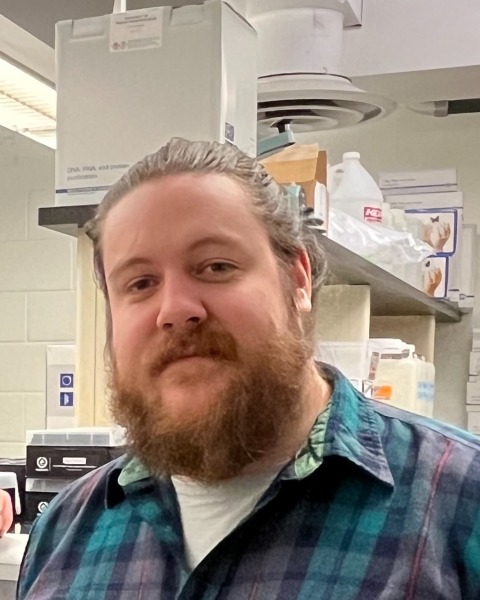Back
PATH TO A CURE
Poster Session
(636) Increased nonsense suppressor tRNA readthrough potency through sequence optimization
Thursday, November 3, 2022
12:00 PM – 12:40 PM ET

Joseph J. Porter, PhD
Postdoctoral Research Associate
University of Rochester Medical Center
Rochester, New York, United States- JL
John D. Lueck
Assistant Professor
University of Rochester Medical Center, United States
Presenting Author(s)
Co-Author(s)
Background: Nonsense mutations or premature termination codons (PTCs) occur when a canonical triplet nucleotide codon is converted into one of three stop codons (TGA, TAG and TAA). These mutations make up 10-15% of all genetic lesions that cause disease including Cystic Fibrosis (CF). Nonsense mutations are challenging targets for drug discovery as no protein is produced and the therapeutic targets are shifted to transcription and translation of the affected gene. While current CF therapeutics target CFTR protein, for nonsense mutations, the therapeutic target must shift to CFTR transcription, mRNA degradation, and translation of the PTC-containing CFTR transcript. We have recently demonstrated the function of a series of anticodon edited tRNAs (ACE-tRNAs) to suppress PTCs in 16HBE14GE human airway epithelial cells with PTC-containing CFTR. We have demonstrated using whole-cell patch clamp that R1162X-16HBEge cells transfected with a plasmid containing 4x-ACE-tRNAArg can rescue ~75% of WT CFTR channel function and that W1282X-16HBEge cells transfected with a plasmid containing 4x-ACE-tRNALeu can rescue ~90% of WT CFTR channel function. While these results demonstrated a rescue of CFTR channel function well in excess of the threshold for a positive therapeutic effect, delivery of ACE-tRNA DNA vectors to epithelial cells remains a significant hurdle. By increasing the potency per unit delivered, fewer ACE-tRNA copies will be needed to reach the same level of CFTR rescue.
Methods: We aimed to increase the nonsense readthrough potency of ACE-tRNAs by promoting transcription and translation processes associated with their expression, maturation, and function in translation. ACE-tRNAs when expressed from DNA require efficient transcription and post-transcriptional processing. To that end we utilized a high-throughput-cloning and screening platform based on a PTC-containing NanoLuc luciferase to screen a 314-member 55 bp 5’ upstream control element library, a 256-member 4 bp 3’ trailer library, and a 386-member 35 bp 3’ trailer library. Whether delivered as DNA or RNA the ACE-tRNA interactions with the translational apparatus should also be optimized. To that end we screened a 256-member ACE-tRNAArg anticodon loop library, a 28-member T-stem library for each of ACE-tRNAArg, ACE-tRNALeu, and ACE-tRNAGly, and a 128-member ‘sticky stem’ library for each of ACE-tRNAArg and ACE-tRNALeu meant to increase stability and folding of these ACE-tRNAs.
Results: We were able to determine extragenic elements, that is 5’ and 3’ sequences, that increase ACE-tRNA PTC suppression efficiency at least 2-fold. Improvements to intragenic sequences, that is t-stems and ‘sticky stems’, increased ACE-tRNA PTC suppression efficiency between 2- and 4-fold. All told these improvements promise to lower the hurdle for therapeutic delivery of ACE-tRNAs to epithelial cells.
Conclusions: With these ACE-tRNA sequences containing optimal transcription and translation elements we are well positioned for delivery in vivo.
Acknowledgements: Funding for this work was provided by a Cystic Fibrosis Foundation Postdoctoral Fellowship to JJP (PORTER20F0) and Cystic Fibrosis Foundation and NIH grants to JDL (LUECK20GO, and NHLBI 1 R01 HL153988-01A1 respectively).
References:
Methods: We aimed to increase the nonsense readthrough potency of ACE-tRNAs by promoting transcription and translation processes associated with their expression, maturation, and function in translation. ACE-tRNAs when expressed from DNA require efficient transcription and post-transcriptional processing. To that end we utilized a high-throughput-cloning and screening platform based on a PTC-containing NanoLuc luciferase to screen a 314-member 55 bp 5’ upstream control element library, a 256-member 4 bp 3’ trailer library, and a 386-member 35 bp 3’ trailer library. Whether delivered as DNA or RNA the ACE-tRNA interactions with the translational apparatus should also be optimized. To that end we screened a 256-member ACE-tRNAArg anticodon loop library, a 28-member T-stem library for each of ACE-tRNAArg, ACE-tRNALeu, and ACE-tRNAGly, and a 128-member ‘sticky stem’ library for each of ACE-tRNAArg and ACE-tRNALeu meant to increase stability and folding of these ACE-tRNAs.
Results: We were able to determine extragenic elements, that is 5’ and 3’ sequences, that increase ACE-tRNA PTC suppression efficiency at least 2-fold. Improvements to intragenic sequences, that is t-stems and ‘sticky stems’, increased ACE-tRNA PTC suppression efficiency between 2- and 4-fold. All told these improvements promise to lower the hurdle for therapeutic delivery of ACE-tRNAs to epithelial cells.
Conclusions: With these ACE-tRNA sequences containing optimal transcription and translation elements we are well positioned for delivery in vivo.
Acknowledgements: Funding for this work was provided by a Cystic Fibrosis Foundation Postdoctoral Fellowship to JJP (PORTER20F0) and Cystic Fibrosis Foundation and NIH grants to JDL (LUECK20GO, and NHLBI 1 R01 HL153988-01A1 respectively).
References:
